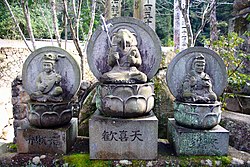Daishō-in
| Daishō-in | |
|---|---|
大聖院 | |
 Niōmon Gate | |
| Religion | |
| Affiliation | Buddhism |
| Sect | Shingon |
| Prefecture | Hiroshima |
| Year consecrated | 806 |
| Location | |
| Country | Japan |
| Prefecture | Hiroshima |
| Architecture | |
| Founder | Kūkai |





Daishō-in or Daisyō-in (大聖院, lit. 'Great Holy Temple'), also called Suishō-ji (水精寺, lit. 'Crystal Temple'), is a historic Japanese Buddhist temple complex with many temples and statues on Mount Misen, the holy mountain on the island of Itsukushima, off the coast of Hatsukaichi, Hiroshima, Japan. It is the 14th temple in the Chūgoku 33 Kannon Pilgrimage and famous for the maple trees and their autumn colors. Including Mt. Misen, Daishō-in is within the World Heritage Area of Itsukushima Shrine.
In this temple there is a flame which is said to have been burning since its foundation, for more than 1200 years.[1][2]
History
[edit]This section includes a list of general references, but it lacks sufficient corresponding inline citations. (June 2024) |
- According to tradition, Daishō-in was founded by the monk Kūkai, also known posthumously as Kōbō-Daishi (弘法大師), in the year 806, the 1st year of the Daidō era.
- Kūkai was one of the most famous monks in Japan and the founder of Shingon Buddhism.
- Made head temple of one of denomination of Shingon Buddhism and the oldest temple on Itsukushima.
- By an Imperial order of Emperor Toba, it was the place to pray for the peace and security of the nation.
- Emperor Meiji stayed there on July 31, 1885, for his visit to Itsukushima Shrine.
- Repair work for the trail to Mt. Misen was finished in 1905.
- It was done by the donation of Itō Hirobumi.
- Heavy damage by 19th typhoon on September 27, 1991.
- Held a memorial service to congratulate the restoration of the damage on October 10, 1998.
- The 14th Dalai Lama visited Itsukushima to celebrate the 1200th-year of Daishō-in from 3 to 8 November 2006.[3]
There are also many buildings, gates of the temple and many statues of Kannon, Jūichimen Kannon, Fudō-myōō (Acala) and Seven Lucky Gods on and around Mt. Misen.
The temple was the administrator of the Itsukushima shrine before Meiji Restoration forbade (Shinbutsu bunri) syncretism (Shinbutsu-shūgō) between Shinto and Buddhism in 1868.[4]
Events
[edit]This section is empty. You can help by adding to it. (July 2010) |
See also
[edit]- Itsukushima
- Kūkai
- Shingon Buddhism
- Kannon
- Chūgoku 33 Kannon Pilgrimage
- Mt. Misen
- Acala
- Seven Lucky Gods
- Glossary of Japanese Buddhism
References
[edit]- ^ Rowthorn, Chris (2009). Lonely Planet Japan. Lonely Planet. p. 470. ISBN 978-1-74179-042-9. Retrieved 2010-07-02.
- ^ Nihonsankei. "Miyajima". The three most scenic spots in Japan. Archived from the original on 2007-12-15. Retrieved 2007-06-25.
- ^ Martin Repp, H.H. The 14th Dalai Lama and the Japanese Buddhists, An Account and Analysis of Complicated Interactions, Japanese Religions Vol. 33 (1 & 2): 103-125
- ^ Miyajima Misen Daiso-In Temple, Official Publication, http://www.galilei.ne.jp/daisyoin/
